[English] 日本語
 Yorodumi
Yorodumi- PDB-1xhy: X-ray structure of the Y702F mutant of the GluR2 ligand-binding c... -
+ Open data
Open data
- Basic information
Basic information
| Entry | Database: PDB / ID: 1xhy | ||||||
|---|---|---|---|---|---|---|---|
| Title | X-ray structure of the Y702F mutant of the GluR2 ligand-binding core (S1S2J) in complex with kainate at 1.85 A resolution | ||||||
 Components Components | Glutamate receptor | ||||||
 Keywords Keywords | MEMBRANE PROTEIN / Ionotropic glutamate receptor GluR2 / mutant / ligand-binding core / kainate complex | ||||||
| Function / homology |  Function and homology information Function and homology informationspine synapse / dendritic spine neck / dendritic spine head / cellular response to amine stimulus / perisynaptic space / Activation of AMPA receptors / ligand-gated monoatomic cation channel activity / AMPA glutamate receptor activity / response to lithium ion / Trafficking of GluR2-containing AMPA receptors ...spine synapse / dendritic spine neck / dendritic spine head / cellular response to amine stimulus / perisynaptic space / Activation of AMPA receptors / ligand-gated monoatomic cation channel activity / AMPA glutamate receptor activity / response to lithium ion / Trafficking of GluR2-containing AMPA receptors / kainate selective glutamate receptor activity / AMPA glutamate receptor complex / cellular response to glycine / extracellularly glutamate-gated ion channel activity / immunoglobulin binding / asymmetric synapse / ionotropic glutamate receptor complex / conditioned place preference / regulation of receptor recycling / glutamate receptor binding / Unblocking of NMDA receptors, glutamate binding and activation / positive regulation of synaptic transmission / regulation of synaptic transmission, glutamatergic / response to fungicide / cytoskeletal protein binding / glutamate-gated receptor activity / regulation of long-term synaptic depression / extracellular ligand-gated monoatomic ion channel activity / cellular response to brain-derived neurotrophic factor stimulus / glutamate-gated calcium ion channel activity / presynaptic active zone membrane / somatodendritic compartment / dendrite membrane / ionotropic glutamate receptor binding / ligand-gated monoatomic ion channel activity involved in regulation of presynaptic membrane potential / ionotropic glutamate receptor signaling pathway / dendrite cytoplasm / synaptic membrane / dendritic shaft / SNARE binding / transmitter-gated monoatomic ion channel activity involved in regulation of postsynaptic membrane potential / synaptic transmission, glutamatergic / PDZ domain binding / protein tetramerization / establishment of protein localization / postsynaptic density membrane / cerebral cortex development / modulation of chemical synaptic transmission / receptor internalization / Schaffer collateral - CA1 synapse / terminal bouton / synaptic vesicle / synaptic vesicle membrane / presynapse / signaling receptor activity / amyloid-beta binding / presynaptic membrane / growth cone / scaffold protein binding / perikaryon / chemical synaptic transmission / dendritic spine / postsynaptic membrane / neuron projection / postsynaptic density / axon / external side of plasma membrane / neuronal cell body / synapse / dendrite / protein kinase binding / protein-containing complex binding / glutamatergic synapse / cell surface / endoplasmic reticulum / protein-containing complex / identical protein binding / membrane / plasma membrane Similarity search - Function | ||||||
| Biological species |  | ||||||
| Method |  X-RAY DIFFRACTION / X-RAY DIFFRACTION /  SYNCHROTRON / SYNCHROTRON /  MOLECULAR REPLACEMENT / Resolution: 1.85 Å MOLECULAR REPLACEMENT / Resolution: 1.85 Å | ||||||
 Authors Authors | Frandsen, A. / Pickering, D.S. / Vestergaard, B. / Kasper, C. / Nielsen, B.B. / Greenwood, J.R. / Campiani, G. / Gajhede, M. / Schousboe, A. / Kastrup, J.S. | ||||||
 Citation Citation |  Journal: Mol.Pharmacol. / Year: 2005 Journal: Mol.Pharmacol. / Year: 2005Title: Tyr702 Is an Important Determinant of Agonist Binding and Domain Closure of the Ligand-Binding Core of GluR2. Authors: Frandsen, A. / Pickering, D.S. / Vestergaard, B. / Kasper, C. / Nielsen, B.B. / Greenwood, J.R. / Campiani, G. / Fattorusso, C. / Gajhede, M. / Schousboe, A. / Kastrup, J.S. #1:  Journal: J.Mol.Biol. / Year: 2002 Journal: J.Mol.Biol. / Year: 2002Title: Structural basis for AMPA receptor activation and ligand selectivity: Crystal structures of five agonist complexes with the GluR2 ligand binding core. Authors: Hogner, A. / Kastrup, J.S. / Jin, R. / Liljefors, T. / Mayer, M.L. / Egebjerg, J. / Larsen, I. / Gouaux, E. #2:  Journal: Neuron / Year: 2000 Journal: Neuron / Year: 2000Title: Mechanism for activation and antagonism of an AMPA-sensitive glutamate receptor: Crystal structures of the GluR2 ligand binding core. Authors: Armstrong, N. / Gouaux, E. #3:  Journal: Protein Sci. / Year: 1998 Journal: Protein Sci. / Year: 1998Title: Probing the ligand binding domain of the GluR2 receptor by proteolysis and deletion mutagenesis defines domain boundaries and yields a crystallizable construct. Authors: Chen, G.Q. / Sun, R. / Jin, R. / Gouaux, E. | ||||||
| History |
| ||||||
| Remark 400 | COMPOUND NATIVE GLUR2 IS A MEMBRANE PROTEIN. S1S2J COMPRISES THE LIGAND BINDING CORE OF THE PROTEIN. ...COMPOUND NATIVE GLUR2 IS A MEMBRANE PROTEIN. S1S2J COMPRISES THE LIGAND BINDING CORE OF THE PROTEIN. TRANSMEMBRANE PARTS OF THE PROTEIN HAVE BEEN REPLACED BY A GLY-THR LINKER (RESIDUES 115-116). THEREFORE, THE SEQUENCE MATCHES DISCONTINUOUSLY WITH THE REFERENCE DATABASE. | ||||||
| Remark 999 | SEQUENCE Residues 528-652 in dbref have been replaced by a Gly-Thr (115-116) linker |
- Structure visualization
Structure visualization
| Structure viewer | Molecule:  Molmil Molmil Jmol/JSmol Jmol/JSmol |
|---|
- Downloads & links
Downloads & links
- Download
Download
| PDBx/mmCIF format |  1xhy.cif.gz 1xhy.cif.gz | 75.9 KB | Display |  PDBx/mmCIF format PDBx/mmCIF format |
|---|---|---|---|---|
| PDB format |  pdb1xhy.ent.gz pdb1xhy.ent.gz | 55 KB | Display |  PDB format PDB format |
| PDBx/mmJSON format |  1xhy.json.gz 1xhy.json.gz | Tree view |  PDBx/mmJSON format PDBx/mmJSON format | |
| Others |  Other downloads Other downloads |
-Validation report
| Summary document |  1xhy_validation.pdf.gz 1xhy_validation.pdf.gz | 454.8 KB | Display |  wwPDB validaton report wwPDB validaton report |
|---|---|---|---|---|
| Full document |  1xhy_full_validation.pdf.gz 1xhy_full_validation.pdf.gz | 455.8 KB | Display | |
| Data in XML |  1xhy_validation.xml.gz 1xhy_validation.xml.gz | 15.9 KB | Display | |
| Data in CIF |  1xhy_validation.cif.gz 1xhy_validation.cif.gz | 24.2 KB | Display | |
| Arichive directory |  https://data.pdbj.org/pub/pdb/validation_reports/xh/1xhy https://data.pdbj.org/pub/pdb/validation_reports/xh/1xhy ftp://data.pdbj.org/pub/pdb/validation_reports/xh/1xhy ftp://data.pdbj.org/pub/pdb/validation_reports/xh/1xhy | HTTPS FTP |
-Related structure data
| Related structure data | 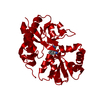 1syhC 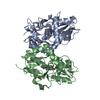 1syiC  1fw0S S: Starting model for refinement C: citing same article ( |
|---|---|
| Similar structure data |
- Links
Links
- Assembly
Assembly
| Deposited unit | 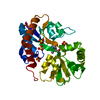
| ||||||||
|---|---|---|---|---|---|---|---|---|---|
| 1 | 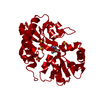
| ||||||||
| Unit cell |
|
- Components
Components
| #1: Protein | Mass: 29205.682 Da / Num. of mol.: 1 Fragment: GluR2 flop ligand-binding core (S1S2J), UNP residues 413-527 and 653-796 Mutation: Y702F Source method: isolated from a genetically manipulated source Source: (gene. exp.)   | ||||||
|---|---|---|---|---|---|---|---|
| #2: Chemical | ChemComp-SO4 / #3: Chemical | ChemComp-KAI / | #4: Water | ChemComp-HOH / | Has protein modification | Y | |
-Experimental details
-Experiment
| Experiment | Method:  X-RAY DIFFRACTION / Number of used crystals: 1 X-RAY DIFFRACTION / Number of used crystals: 1 |
|---|
- Sample preparation
Sample preparation
| Crystal | Density Matthews: 2.4 Å3/Da / Density % sol: 41.6 % |
|---|---|
| Crystal grow | Temperature: 280 K / Method: vapor diffusion, hanging drop / pH: 6.5 Details: PEG1000, Li2SO4, cacodylate , pH 6.5, VAPOR DIFFUSION, HANGING DROP, temperature 280K |
-Data collection
| Diffraction | Mean temperature: 110 K |
|---|---|
| Diffraction source | Source:  SYNCHROTRON / Site: SYNCHROTRON / Site:  EMBL/DESY, HAMBURG EMBL/DESY, HAMBURG  / Beamline: X11 / Wavelength: 0.811 Å / Beamline: X11 / Wavelength: 0.811 Å |
| Detector | Type: MARRESEARCH / Detector: CCD / Date: Nov 3, 2003 |
| Radiation | Protocol: SINGLE WAVELENGTH / Monochromatic (M) / Laue (L): M / Scattering type: x-ray |
| Radiation wavelength | Wavelength: 0.811 Å / Relative weight: 1 |
| Reflection | Resolution: 1.85→20.4 Å / Num. all: 24433 / Num. obs: 24433 / % possible obs: 98.9 % / Observed criterion σ(F): -3 / Observed criterion σ(I): -3 / Redundancy: 3.5 % / Biso Wilson estimate: 16 Å2 / Rmerge(I) obs: 0.073 / Net I/σ(I): 16.1 |
| Reflection shell | Resolution: 1.85→1.88 Å / Rmerge(I) obs: 0.432 / Mean I/σ(I) obs: 3 / % possible all: 96 |
- Processing
Processing
| Software |
| ||||||||||||||||||||||||||||||||||||||||||||||||||||||||||||||||||||||||||||||||||||||||||||||||||||
|---|---|---|---|---|---|---|---|---|---|---|---|---|---|---|---|---|---|---|---|---|---|---|---|---|---|---|---|---|---|---|---|---|---|---|---|---|---|---|---|---|---|---|---|---|---|---|---|---|---|---|---|---|---|---|---|---|---|---|---|---|---|---|---|---|---|---|---|---|---|---|---|---|---|---|---|---|---|---|---|---|---|---|---|---|---|---|---|---|---|---|---|---|---|---|---|---|---|---|---|---|---|
| Refinement | Method to determine structure:  MOLECULAR REPLACEMENT MOLECULAR REPLACEMENTStarting model: 1FW0 Resolution: 1.85→20.37 Å / Cor.coef. Fo:Fc: 0.962 / Cor.coef. Fo:Fc free: 0.936 / SU B: 2.564 / SU ML: 0.078 / Isotropic thermal model: restrained / Cross valid method: THROUGHOUT / σ(F): 0 / ESU R: 0.124 / ESU R Free: 0.127 / Stereochemistry target values: Engh & Huber Details: Residues 1-2 and 263 were not located in the electron density map
| ||||||||||||||||||||||||||||||||||||||||||||||||||||||||||||||||||||||||||||||||||||||||||||||||||||
| Solvent computation | Ion probe radii: 0.8 Å / Shrinkage radii: 0.8 Å / VDW probe radii: 1.4 Å / Solvent model: BABINET MODEL WITH MASK | ||||||||||||||||||||||||||||||||||||||||||||||||||||||||||||||||||||||||||||||||||||||||||||||||||||
| Displacement parameters | Biso mean: 16.048 Å2
| ||||||||||||||||||||||||||||||||||||||||||||||||||||||||||||||||||||||||||||||||||||||||||||||||||||
| Refinement step | Cycle: LAST / Resolution: 1.85→20.37 Å
| ||||||||||||||||||||||||||||||||||||||||||||||||||||||||||||||||||||||||||||||||||||||||||||||||||||
| Refine LS restraints |
| ||||||||||||||||||||||||||||||||||||||||||||||||||||||||||||||||||||||||||||||||||||||||||||||||||||
| LS refinement shell | Resolution: 1.85→1.886 Å / Total num. of bins used: 20 /
|
 Movie
Movie Controller
Controller


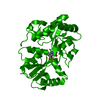

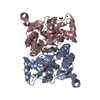

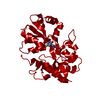
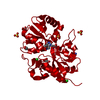
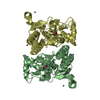
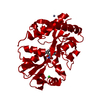
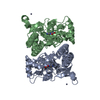
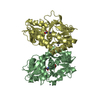
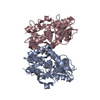

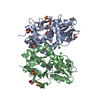



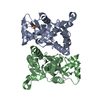
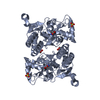
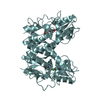

 PDBj
PDBj









